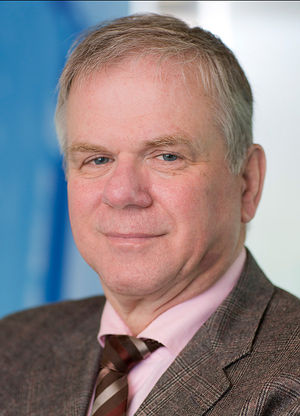Martin A. van den Brink
- Fields of study
- Semiconductors
- Awards
- IEEE Cledo Brunetti Award, IEEE Robert N. Noyce Medal
Biography
For over 30 years, Martin A. van den Brink’s vision has driven advances in optical lithography methods that enable smaller, faster, and more energy-efficient chips. Optical lithography, a microfabrication process in which light-sensitive chemicals are used to transfer circuit patterns onto chip wafers, is the technology of choice for mass production of integrated circuits and a key enabler of the continued miniaturization of chips. Under Dr. van den Brink’s leadership, innovations including alignment modules, focusing and leveling methods, and staging concepts have continued to drive the industry forward, providing nanometer-scale accuracy. The TWINSCAN exposure platform, 193-nm immersion lithography scanners, and extreme ultraviolet scanners, have allowed printing at smaller and smaller dimensions every year. His work has truly shaped the optical lithography field.
One of ASML’s first employees from its start-up in 1984, Dr. van den Brink’s technical direction has positioned ASML as the world’s largest supplier of essential optical lithography systems for the semiconductor industry. Dr. van den Brink has been responsible for practically all major technical decisions at ASML. He introduced modular design and an open innovation policy with technology and manufacturing partners during the 1980s. In the 1990s, he was instrumental in ASML’s move from step to scan lithography. His introduction of the TWINSCAN dual-stage architecture in 2001 provided major improvements in productivity and accuracy. Under Dr. Van den Brink’s leadership, ASML delivered one of the most important innovations for the continuation of Moore’s Law: immersion lithography (2004), which provided a higher-resolution pattering solution to allow continued scaling down to 40 nm. It remains the lithography process of choice for the semiconductor industry. Dr. van den Brink has also pioneered holistic lithography for cost-effective multiple patterning, which has enabled imaging resolution below 20 nm. He currently oversees ASML’s biggest innovation effort to date: the introduction of extreme ultraviolet (EUV) lithography, which will take single-exposure patterning down to ever smaller resolutions over the next ten years. This will enable Moore’s Law to continue for at least another decade from a cost-effective patterning perspective.
Dr. Van den Brink is President of ASML, Veldhoven, The Netherlands. Van den Brink was the recipient of the 2014 IEEE Cledo Brunetti Award and the 2015 IEEE Robert N. Noyce Medal.
